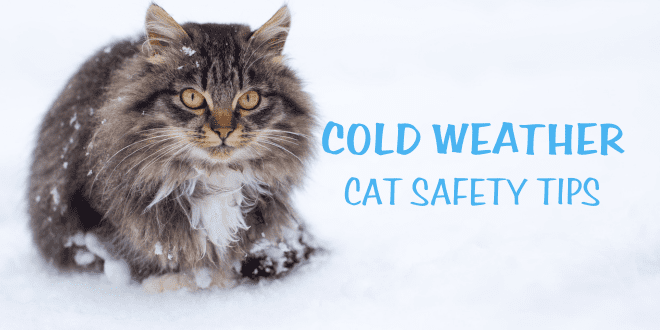Keep Your Cat Indoors
This is the number one way to keep your cat safe and warm in the winter. Cats are at risk outdoors all year long but the danger increases in extreme weather. An outdoor cat can suffer frostbite on paws and ear tips and can actually end up freezing to death.
Outdoor cats who look for shelter may seek warmth in very dangerous places such as inside the warm engine of a car or inside wheel wells. This often ends up being fatal when an unsuspecting person starts the car up, or in the case of a cat inside the wheel well, puts the car in motion.
Bang on Your Car Hood to Alert a Cat
To protect the cats and other small animals who may seek warmth in car engines, give the hood of your car a couple of good hard smacks to startle any animal who may be in there. This will hopefully give an animal time to escape to safety. Walk around your car and check wheel wells.
Identification
Even if you keep your cat indoors exclusively, use some form of identification. Microchipping is the most reliable because collars with ID tags can come off. It’s not uncommon for an indoor cat to slip out the door and find herself lost and confused in the frigid outdoors. The best way to get your cat returned to you is through identification. If you do use microchipping, make sure you keep the registry information current.
Clean Up All Antifreeze Spills to Protect Cats
Traditional antifreeze has a sweet taste and can be enticing for animals to ingest. Antifreeze leaks can occur, so be aware of any puddles you see in your driveway or garage. If you happen to spill antifreeze while adding it to your car, clean it up immediately, wipe antifreeze containers on the outside ,and tightly seal before storing them away in the garage.
Don’t Leave Your Cat in the Car
When traveling, don’t leave your cat in the cold car. Depending on the weather, the inside of the car can become cold enough to be fatal to your cat. In the summer, the inside of the car can become an oven that can turn lethal in mere moments and the winter temperature can be just as dangerous.
Watch for Frostbite on Outdoor Cats
If you allow your cat outdoors, keep in mind that they are susceptible to frostbite, especially on the ear tips. Always make sure your cat is indoors when the temperature gets uncomfortable and check your cat over physically to look for signs of frostbite.
Check the Paw Pads of Your Outdoor Cat
If you allow your cat outdoors during snowy or icy conditions, the paws pads can become burned and irritated by the ice melting salt products that get spread on sidewalks and driveways. To protect outdoor animals, switch to one of the pet safe ice melt products available instead of using traditional rock salt. You should also wipe the cat’s feet before she has a chance to begin licking her paws.
Create a Draft-Free Indoor Environment for Cats
Even indoor cats can get uncomfortably cold. Your cat’s favorite napping areas and bedding should be located away from drafts. Since many cats love to sit at the window and watch the outdoor activity, address any drafts that leak through poorly sealed windows. If the house is drafty in general, set up some cozy napping places for your cat by using semi-enclosed beds or heated pet beds. The self-warming beds are safest because they reflect the cat’s body heat. If you use an electric heating bed or pad, cover it with a towel and make sure your cat is mobile enough to move away from the heat to avoid burns.

Pay Close Attention to Sick or Older Cats
Cats who are inactive, have lost muscle tone, lost weight, or have trouble maintaining their body temperature will need extra care to ensure they have adequate warm places for snuggling. An older cat with arthritis will truly appreciate being able to curl up in a soft, warm bed. Be extra mindful of cats who need a little extra help when it comes to staying warm and comfy. If your older cat has been used to going outdoors, this is the time to transition to indoor life. The cold outdoor environment is especially tough on the stiff joints of older, arthritic cats. Older cats can also become more easily disoriented, especially in snow, so keep your cat indoors.
Take Action When You See a Cat Outdoors
All-too-often, many people ignore the cat spotted outdoors. If the weather is dangerously cold, don’t assume that cat will find her way home in time. Do your best to bring that cat indoors for protection from harsh and dangerous temperatures. Hopefully, the cat will be mircochipped and if you bring her to the shelter or veterinary clinic, the family can be contacted. At the very least, keep the cat safely indoors during bad weather. Don’t assume that someone else will take care of a lost outdoor cat.
Taking Care of Community Cats
If you feed and care for community cats, provide dry, safe, outdoor shelters that will protect them from harsh temperatures and winds. Keep in mind that the cats will create moisture inside the shelters so you’ll have to change whatever bedding you use on a regular basis. Use heated bowls for water or else you’ll have to change the water multiple times a day. Keep track of food as well because of how quickly it can freeze. For information on how to create outdoor shelters for feral cats visit the website of Alley Cat Allies.
Need More Information on Cat Behavior?
For more information on cat behavior and training, refer to the books by best-selling author Pam Johnson-Bennett. Pam’s books are available at bookstores and online. We’ve included Amazon links here on our website.
If you have a question regarding your cat’s health, please contact your veterinarian. This article is not intended as a replacement for your cat’s veterinary care.






